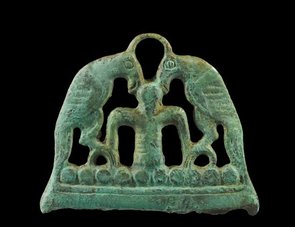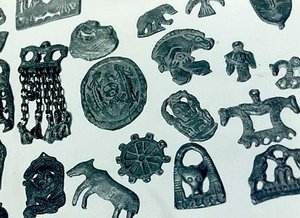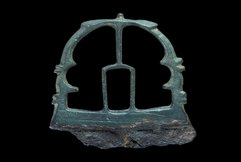A Viking Age firesteel - the razor's edge ?
This week an artefact of the Viking Age, wich have been a case of heavy debate, still going on.
Sold as a viking firesteel with Odin and his raven, Hüginn and Muninn, depicted, I was very thrilled about this addition in my collection. First of all because the image of Odin and his companying birds is so outspoken clear. If it is the image of Odin with his raven is a matter of debate within itself. Apart of being a pagan image it could as well have been a Christian alike image of the ressurrection Of Christ.
Set aside that image, the artefact itself is matter to debate. Sold as a described, a man called 'Sergei' mailed me more than uptight, making me out for somewhat of a fool..
'... firesteels (steel is a key word here) were all made out of iron of high carbon content during the entire history of mankind. The bronze and other copper alloys are not strong enough to serve the purpose. What you have is a decorative anthropomorphic (combining elements of a man and animals or birds simultaneously) pendant or a plague of Perm (Finno-Ugric tribes) animal style. Such decor pendants, plagues, clasps and belt ends served as amulets against evil spirits in medieval times..'
Addressed as being Permian animal style this would refer to the ancient history of Finno-Ugric peoples living west of the Urals – Zyrian Komis, Permian Komis and Udmurts – and their art, most frequently referred to as ‘the Permian animal style’.
It was at its prime from the 6th to the 8th and 9th c. and its end fell to the 14th c. Treating Permian art, we should bear in mind that the art of Ob-Ugrians is fairly similar to that of Permian peoples and that at the time there were also the Ob-Ugrians Mansis (or Voguls) living west of the Urals.
And indeed, as one searchs for 'Perm animal style' images, one stumbles upon an image (on the right beneath) wich depicts a similar artefact..
As one can see on the page on my website: http://travellingnorth.nl/Viking-artefacts/odin-with-raven-firesteel.html I also have some mysterious images out of a (antique ?) Russian book, addressing this kind of artefact. But not known to me until now, wich book this is.
So.. an amulet after all ?
The debate continued though, literally on the razor's edge..
Being somewhat of the curator of my own private collection of artefacts, one needs to protect his artefacts from bronze disease andsoforth. I got in contact with someone, priorly working at the Dutch National Archaeological Services, Johan Langelaar, who also made me out for something like a fool. Again..
Well.. one thing was for sure.. this amulet wasn't going to protect me for being held for a fool ..
'It is a shaving razor !' he cried out. 'Do not let anyone tell you otherwise ! It is a shaving razor !'
'Take a look at the iron on the bottom of the razor. That had detoriated, the iron part was the razor where wich one have shaved itself'.
Ok.. a firesteel, an amulet and now a shaving razor..
Of course I did my own research then.
I came across a book, written by Spiro Svoronos, 'Medieval firesteels' wich addresses an openwork artefact as a shaving razor. Right at the same time, I aquired another artefact from Timeline Originals, - see image beneath this article - wich had been addressed as a firesteel also, but looks very much the same as the type of openwork artefact on the image out of Spiro Svorono's book about medieval firesteels. The reference given bij Timeline Originals happens to be a dissatisfying one too, as it refers to a quite different kind of firesteel type artefact (Cf. Lehtosalo-Hilander, P-L., Luistari II The Artefacts, Helsinki, 1982, fig.21.) A so called 'horse and rider' type of firesteel. (as a link to the image hereby attached).
A shaving razor also ? And of a much older date than being described as 'viking' ?
I try to get a copy of this 'Medieval firesteels' book. It seems unavailable right now.
And for one thing I have learned over the years.
To be open for other opnions, and let newly discovered opinions from someone else or by myself alter as being 'true' presented opnions (from by example from someone sells the object in the first place).
Yes, we see a man with birds. But what followed as described is as intruiging as well..
The debate goes on...
Any thoughts on this both artefacts ? Share them with me on: vikingsandartefacts@yahoo.com
Thomas Kamphuis, August 20th 2015
Link to prior blog of July 30th 2015.
References:
Hammond, B. British Artefacts, Volume 2, Middle Saxon and Viking, p. 106, fig. 1.16-f.
Svoronos, S. Medieval firesteels (Printed in USA by Classic Printers in August 2004 ( ISBN 0-9761088-0-1 ) Copperfield Noise Publishing, Houston)
Images of Perm animal Style artefacts
Article on the Permian Art Style see: http://www.folklore.ee/folklore/vol18/permian.pdf
Not used in this article, but the book from
Cacciandra, V. & Cesati A., Fire steels Published by Umberto Allemandi & Co. (1996)
ISBN 10: 8842206873 ISBN 13: 9788842206873, might shed some new light also on this debate..
An expensive book, I'm considering buying it. Without a thorough library, a collector and curator is nowhere ! (a salesman of artefacts also !)
Well. I could have been with these stones until after dark, but as my wife wanted to travel on.. well.. I see you again, some day, hogback stones from Gosforth. And if you happen to be there one day, do not forget that monument on the outside...
Further on with the Cumbrian hogbacktour !
In - yes, luckily again in - St. Peter's church in Heysham, there is a truly beautiful hogback stone. The guide told us, it had been studyied by Thor Ewing, a writer, in 2000. in 'Understanding the Heysham hogback' A tenth century sculpted stone monument and its context (link), Thor Ewing tells in detail what he dicovered on the both sides of this hogback stone.
Just being brought in the church as late as the 1970's accompanied with some protest here and there among the church visitors, considered as being a token of old paganism, it had been remarkably nice preserved, and a lot of detail can be seen, still. Truly worthwile a visit.
I had a small debate with the guide in the church if the - zoomorphic, in my opinion - faces on the sides were lions (or hippo's). The guide doubted if the vikings could have known about lions. Well I guess so, concerning the runes on the Ancient Greek lion statue at the Arsenal, Venice. For example. Vikings did travel south..
But when he told me he was doubting the vikings 'discovered' (as the native inhabitants were of course, in the first place) America before Columbus, I decided to rest my case..
One has to know when to start and to end a conversation ..
Just discovered the book in a bookstore written by Geoff Holder - The guide to the mysterious Lake District, I knew there had to be another hogback stone in Lowther, St. Micheal's Church. With a promising image described in the text of 'a naval and a land-based force of shield-bearing vikings above a fish and what might be a coiled sea serpent. On the reverse is a row of female figures with snakes, possibly a representation of the hideous hag Hel'. Wow. If that did not sound as a true pagan promised land ..
Not complaing too much after all we have seen, this visit was the dissapointing one of them all. But if you wife states 'I am happy to have seen them' and I am answering 'Measuring is knowing' and the even more obligate verb 'handling 'if we did not see it at all, we wouldn't have known anything at all of how they were looking' the glass was again half full, at the last day of our journey..
The hogback stone appeared to be just being tolerated within the entrance segment part of the church. As something you never use anymore but you do not throw away - entirely. That sort of feeling emerged when seeing this hogback asylum seekers.. Bed, bath and bread, ás we say in Dutch, but no luxury at all and standing on some outcuts of wood, you would balance the table with at home..
Come on, St. Micheal's Church.. care a bit more of your 'children' !
This hogback stone was moved in the church in 1907. Hogback stones layed partially buried in the churchyard before it was dug up and moved into the church.
The promising depiction of a longship - as certainly can be seen after some studying - see http://vikingminds.co.uk/pages/longship
we have missed !
The stone itself is (157 x 50 x 30 cm) and very worn.
The hogback stones in Cumbria - very diverse in quality, but everyone worth a visit ! Especially on a gloomy day in late October ...
The churches to visit - see photos of resp. St. Andrew's church in Penrith, St. Mary's church in Gosforth, St. Peter's church in Heysham and St. Micheal's church in Lowther.
Did I miss out on another one in Cumbria ? Let me know !
In a next blog I will take you to four - still remaining utterly mysterious- statues 'guarding' the graveyard of St. Andrew's church in Dacre..
For the last blog of October 9th see this link.
References: (as always, links to where the books can be ordered are attached).
Edwards, B.J.N. Vikings in North West England - The artifacts (1998);
Emery, Gordon, CURIOUS CUMBRIA, The Lake District & Beyond: A celebration of Cumbria (2023)
Ewing, T. 'Understanding the Heysham hogback' A tenth century sculpted stone monument and its context ;
Hall, R. Viking Age archaeology in Britain and Ireland (first printed 1990, reprinted with amendments in 1995);
Holder, G. The guide to the mysterious Lake District (2009)
possibly also (as there within the part of Cumbria dealing with Carlisle, the Eden Valley, Barrow-in-Furness, Whitehaven and the west coast is being dealed with)
Holder, G. Paranormal Cumbria (2010)
http://vikingminds.co.uk/pages/longship


